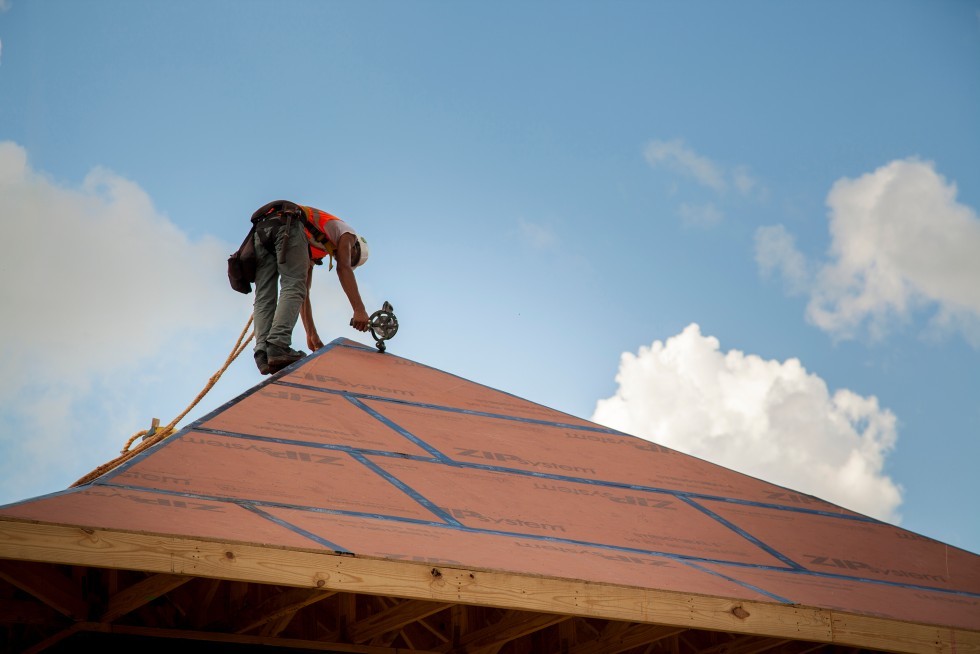
Coastal Builder Uses Sealed Roof Decks to Help Fortify Homes Against Storms
5 Min Read April 3, 2017
When General Contractor John Price moved to Gulfport, Mississippi and began work with premier residential and commercial developer Sapphire Homes, he noticed significant rainfall as a crucial job site variable year-round. According to Price, even outside of the June-to-November hurricane season, rain is an almost-daily reality on build sites in the coastal city, and that can spell trouble for roofs. Price looks to roof deck products that help achieve quick rough dry-in and ensure long-term durability under potential storm threats in his storm-prone coastal area.
“From light showers to tropical storms, oceanfront builds in Gulfport need to stand up to heavy downpours and high winds during and after the build.” Price said.
With ZIP System sheathing and tape, when shingles blow off you have a built-in layer of protection that’s not going anywhere.
How Price Builds Sealed Roof Decks
To provide added protection beyond that of traditional oriented strand board (OSB) and felt roof deck assemblies, Sapphire Homes uses ZIP System® roof sheathing and tape to build a more resilient sealed roof deck. Plus, it helps homeowners meet voluntary resilient building standards that can help reduce wind insurance premiums.
“I used to use OSB and felt, but not anymore,” said Price. “Instead of using the traditional method of boards and a weatherproof layer, ZIP System® sheathing and tape has the moisture barrier built in. It’s a much more advanced product.”
ZIP System sheathing and tape is an innovative structural roof and wall system with an integrated water-resistive barrier that streamlines the weatherization process. The system helps Sapphire Homes get projects dried in quicker in the rain-heavy Gulf Coast area.
“It rains about every other day in the coastal areas,” Price said. “That’s not a problem during a build when you’re using ZIP system products. If you’re in the house looking up, you can see there aren’t any gaps between the boards. And there’s no discoloration that would indicate water intrusion that you often see with alternative roofing products. Even after heavy rains, the roof interior looks good as new, so we’re confident it is sealed tightly.”
New Standards for Roof Durability on the Coast
Sapphire Homes strives to distinguish their company in their coastal market as a builder homeowners can trust to have long-term durability as a top priority. Owner Jason Garner explained this had to be a core part of the company’s brand after the area’s history of devastating hurricane damage including destruction from Hurricane Katrina in 2005.
“Though it’s been over 10 years since Hurricane Katrina, waterfront areas have been slow to re-build because of insurance costs,” said Garner. “By creating more ‘insurable’ homes by following voluntary building guidelines created to help engineer storm-resistant homes, we hope to help lead this community back to enjoying the natural amenities of waterfront home ownership.”
Sapphire Homes follows FORTIFIED® Homes guidelines to make each of their projects as strong and weather resistant as possible. The FORTIFIED Homes program was created by the Insurance Institute for Business and Home Safety (IBHS) to help offer disaster protection for homes in areas susceptible to natural disaster. Formulated after over twenty years of research, FORTIFIED Homes offers a set of design and construction standards that goes above building code requirements to help homes resist damage from natural hazards. Homes are inspected by FORTIFIED Homes professionals and certified, which can enable homeowners to receive insurance benefits. The bronze, silver and gold categories build upon each other, but the main focus of the first level – bronze – is fortifying the roof.
“The roof is the most vulnerable part of the entire house,” Price said. “In areas prone to storms, high winds and hurricanes, shingles are likely going to blow off. In traditional homes, the last line of defense against water intruding through the roof deck is a weatherproof barrier – usually a thin layer of felt – and that will probably blow off, too. Once it does, water can pour in and ruin drywall, flooring and almost everything else on each level of your home. If your roof fails to keep the water out, you’re going to experience significant and costly damage to the rest of your house."
How a Sealed Roof Deck Protects Homes
“With ZIP System sheathing and tape, when shingles blow off you have a built-in layer of protection that’s not going anywhere,” he added. “Because the weatherproof barrier is fused directly to the panels and acrylic tape seals the seams, your roof and house are much better protected.”
ZIP System sheathing and tape comes with a 180-day Exposure Guarantee and is available in 7/16", 1/2" or 5/8" panel thicknesses. With a unique tongue-and-tongue edge profile, panels install easily and are self-spacing. Introduced in 2006 for exterior wall and roof applications, ZIP System sheathing and tape is changing how professionals achieve tight building envelopes.
“We build to a higher standard to meet FORTIFIED guidelines because that’s the company we want to be,” Price said. “We use ZIP System sheathing and tape because it’ a superior product. We want to go above and beyond, and ZIP System products help us do that.”
Discover more from ZIP System roof here.


